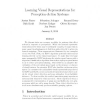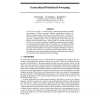181 search results - page 29 / 37 » State Space Reduction For Hierarchical Reinforcement Learnin... |
CDC
2010
IEEE
13 years 2 months ago
2010
IEEE
Abstract-- We consider reinforcement learning, and in particular, the Q-learning algorithm in large state and action spaces. In order to cope with the size of the spaces, a functio...
IJRR
2011
13 years 2 months ago
2011
We discuss vision as a sensory modality for systems that effect actions in response to perceptions. While the internal representations informed by vision may be arbitrarily compl...
GLVLSI
2009
IEEE
14 years 2 months ago
2009
IEEE
The sequential depth determines the completeness of bounded model checking in design verification. Recently, a SATbased method is proposed to compute the sequential depth of a de...
ICML
1996
IEEE
14 years 8 months ago
1996
IEEE
Some of the most successful recent applications of reinforcement learning have used neural networks and the TD algorithm to learn evaluation functions. In this paper, we examine t...
NIPS
1997
13 years 8 months ago
1997
Prioritized sweeping is a model-based reinforcement learning method that attempts to focus an agent’s limited computational resources to achieve a good estimate of the value of ...


